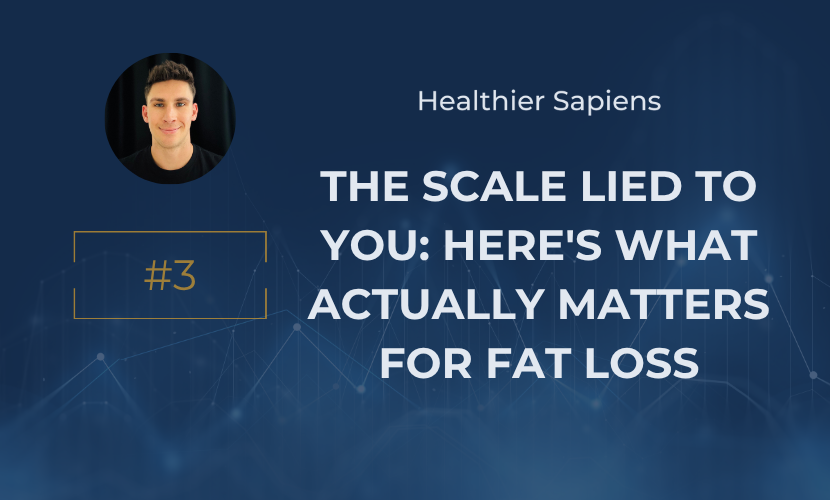The Scale Lied to You: Here's What Actually Matters for Fat Loss
Stop obsessing over the number on your scale. Here's the one measurement that actually tells you if you're making progress.
Tom Mitkus
10/31/20254 min read


I get asked the same question at least once a week.
"Am I actually losing fat, or is this just water weight?"
The person asking has usually dropped some weight on the scale. But they're not celebrating. They're anxious. Second-guessing everything. Wondering if their progress is even real.
Sound familiar?
Here's the brutal truth: most people are measuring the wrong thing entirely.
The Problem with Body Composition Machines
You don't need a fancy body composition machine to know if you're making real progress.
Let me be clear about something: those expensive body comp scanners? Most of them are shit. They'll tell you you've gained 2 kg of muscle in a week. Or that your body fat dropped 3% overnight.
Pure noise.
I've seen clients drop £200 on DEXA scans only to get results that make zero sense based on what we know about their training and nutrition. The machines are inconsistent. They're influenced by hydration, meal timing, the time since your last training session, and even room temperature.
They create more confusion than clarity.
The One Metric That Doesn't Lie
So what should you measure instead?
Your waist circumference. Around your navel. Same spot, same time, every week.
That's it.
Not your weight. Not some algorithm's guess at your body fat percentage. Just a simple tape measure around your middle.
Why Waist Circumference Works
Your waist tells you exactly what's happening with visceral fat—the metabolically active fat that actually matters for your health.
It doesn't lie about water retention. It doesn't fluctuate based on whether you had sushi last night or took creatine this morning.
When your waist goes down, you're losing fat. Period.
When it stays the same while you're "losing weight"? You're losing muscle or water. Not what we want.
Some Interesting Research
Two recent studies highlight why small changes in your approach can lead to significant fat loss results.
Study #1: Vitamin D Enhances Exercise Results
Researchers analyzed 8 randomized controlled trials with 481 adults with overweight or obesity. The protocol was simple: exercise 3 times per week, plus vitamin D supplementation ranging from 1,000 to 50,000 IU weekly.
The results? Adding vitamin D to exercise reduced waist circumference by an extra 1.5 centimeters compared to exercise alone.
In participants over 60 doing aerobic exercise, the difference was even bigger: 2.1 kg more weight loss and a 0.5 point drop in BMI.
My take: The mechanism might be vitamin D supporting muscle performance in older adults, making workouts more effective. It's a small boost, but meaningful over time. However, the mixed findings and small number of studies mean we shouldn't read too much into it yet.
Study #2: Potatoes vs. Rice for Fat Loss
This one surprised me. In a 12-week crossover trial, 24 adults with type 2 diabetes ate either 100 grams of baked white potatoes or 75 grams of white rice daily. Same calories. Same carbs.
The potato group? Their waist dropped by 4.5 centimeters more than the rice group.
Now, before you start loading up on potatoes: this was a small study with industry ties to potato research. We need more data. But it's interesting that food choice might matter beyond just calories and macros.
Real Numbers
My client V provides a perfect example of why waist circumference matters more than scale weight.
He dropped 4 kg in just over 2 weeks. From 96.9 kg to 93 kg.
But here's what matters more: he crushed his half-marathon personal best by 15 minutes.
V didn't come to me about weight loss. He came because his energy was tanking and his performance was flat.
We made two changes:
First, we bumped his protein to 1.8 grams per kilogram of body weight. For him, that meant going from around 120 grams daily to 175 grams.
Second, we swapped all his "healthy" snacks—fruit, homemade energy balls, high-protein desserts—for actual protein and fat sources.
The weight dropped. His waist shrunk. But more importantly, his recovery improved. His training sessions got sharper. His race time proved it.
Here's what most people don't realize: excess fat isn't just aesthetics. It's dragging down every system in your body. Your performance. Your recovery. Your energy. Your sleep.
Strip it off, and everything else levels up.
How to Start Measuring Correctly
Buy a tailor's measuring tape. The flexible fabric kind.
Every Sunday morning, before breakfast, measure your waist at your navel. Not where your pants sit. Right around your belly button.
Keep the tape snug but not tight. Don't suck in. Don't hold your breath.
Write it down.
That's your new north star metric.
One number. Once a week. It'll tell you more than your scale ever will.
What to Expect
A healthy rate of waist reduction is 1-2 centimetres per month when combined with proper nutrition and training.
If you're seeing more than that? Great. You're probably carrying significant visceral fat that's coming off.
If you're seeing less? We need to look at your protein intake, your training stimulus, and whether you're actually in a caloric deficit.
If your waist isn't moving at all but the scale is dropping? Red flag. You're losing muscle or water, not fat. Time to adjust.
The Bottom Line
Stop letting the scale mess with your head.
Your waist circumference is the single best indicator of fat loss progress you can track at home. It's free. It's accurate. And it tells you exactly what you need to know.
Measure once a week. Track the trend over months, not days.
That's how you know if you're actually making progress.

